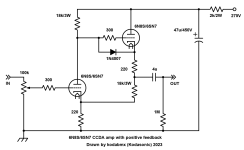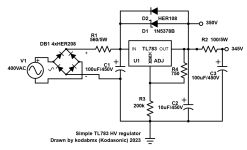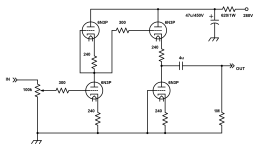Both circuits invert.
The Aikido preamp uses a half-mu amp, so it's gain is nicely predictable and you can plug-and-play different tube types if you want to try tube rolling. You pay for it with 3dB worse signal to noise ratio, but you probably won't notice this in a line stage.
The CCDA has the option for using a small amount of positive feedback for more distortion. Sorry, I mean more 'tubeyness'.
Both are nice circuits. I guess personally I prefer the simplicity and economy of the CCDA.
The Aikido preamp uses a half-mu amp, so it's gain is nicely predictable and you can plug-and-play different tube types if you want to try tube rolling. You pay for it with 3dB worse signal to noise ratio, but you probably won't notice this in a line stage.
The CCDA has the option for using a small amount of positive feedback for more distortion. Sorry, I mean more 'tubeyness'.
Both are nice circuits. I guess personally I prefer the simplicity and economy of the CCDA.
I build both (though my version of the Aikido doesn't inject PSU noise so it's just an actively loaded half-mu amp followed by an actively loaded cathode follower) , and I prefer the actively loaded one. Changing tube types requires little to no effort, and some of the heat gets moved to outside the chassis.
I will also say that the CCDA is a very nice design as well, and I only build it with positive feedback.
I've never made a board for this - always did it point to point.
Koda

I will also say that the CCDA is a very nice design as well, and I only build it with positive feedback.
I've never made a board for this - always did it point to point.
Koda

Sorry, I never built a CCDA, but I have an 6SN7 based Aikido that I used for a while. Sounded Amazingly clear and powerfu, low noise floorl, but I had 2 issues (1) gain was just too much for my system at the time, mainly CD based then back in 2007 or so, and (2) I had a significant motorboating issue with woofer pumping that was not easy to solve. It may have been from my PSU layout / topology or heater setup.
I am considering bringing it back out, and redeploy it as a two box preamp (separate the PSU and the linestage) as I have shifted to vinyl and could use the gain if I tried a MC cart.
I am considering bringing it back out, and redeploy it as a two box preamp (separate the PSU and the linestage) as I have shifted to vinyl and could use the gain if I tried a MC cart.
@kodabmx
Isn’t that the one function which makes it not an Aikido?I build both (though my version of the Aikido doesn't inject PSU noise…
But isn't the point of the Aikido that PS noise can change with tube conduction and changes in current? Forgive me, I'm not very technically minded but something like that... ;-)
All the "Aikido" circuit does is inject the PSU noise in such a way that it is effectively cancelled - it gets rid of hum etc.
Here's a picture of what I mean.
From John Broskie's Tubecad.com: https://www.tubecad.com/2004/blog0011.htm

A regulated power supply is just a better solution to the problem IMHO.
Here's my implementation - costs under 20$ to build (not including the transformer) - and I have boards available.

Here's a picture of what I mean.
From John Broskie's Tubecad.com: https://www.tubecad.com/2004/blog0011.htm
A regulated power supply is just a better solution to the problem IMHO.
Here's my implementation - costs under 20$ to build (not including the transformer) - and I have boards available.

I should add that the 400VAC in question above is based on a square wave drive from a DC-DC boost converter, so 400VAC in gives 400VDC out. 300VAC is more suitable for sine wave power such as from the line.
I guess the Aikido raises a question...
Assuming a decent, regulated B+ supply and a quiet heater supply, does the Aikido noise cancellation make an audible difference? Do you hear 'blacker' backgrounds? Do you hear 'deeper into the details'? Do you hear a 'more expansive soundstage'? Or is the difference inaudible if you're already using a quiet (regulated) B+ supply?
Assuming a decent, regulated B+ supply and a quiet heater supply, does the Aikido noise cancellation make an audible difference? Do you hear 'blacker' backgrounds? Do you hear 'deeper into the details'? Do you hear a 'more expansive soundstage'? Or is the difference inaudible if you're already using a quiet (regulated) B+ supply?
I have a 6SN7 Aikido and a Cary SLP-98. The Cary is basically just parallel 6SN7 plate followers with parallel 6SN7 cathode followers for the output. Compared with the Aikido, the Cary is sluggish and thick-sounding. The Aikido is much more revealing and transparent, as well as lighter on its feet and responsive to the subtleties of recording venue, instrumental tone, etc. That's about as direct a comparison as I'm able to make--same tube compliment in a very different arrangement. My Aikido also has a much simpler power supply, being a 6X5, a cap, a Neurochrome regulator board and a filament regulator board. There isn't much to it, really, yet in my system it's a much more musical piece of equipment. The Cary has a very chunky separate power supply with a lot of filter caps and regulators and such.
I've also tried various single-ended octal arrangements, like a triode-wired 6V6 and other tubes, and they also sounded coarse (and very noisy) compared to the Aikido. I've never seen any actual measurements for an Aikido. Maybe the S/N ratio is better, maybe not, as well as THD, IM, etc. It would be interesting. Has anyone done that? I don't have the proper equipment myself.
I've also tried various single-ended octal arrangements, like a triode-wired 6V6 and other tubes, and they also sounded coarse (and very noisy) compared to the Aikido. I've never seen any actual measurements for an Aikido. Maybe the S/N ratio is better, maybe not, as well as THD, IM, etc. It would be interesting. Has anyone done that? I don't have the proper equipment myself.
I added NFB to some Aikido's I built because as you say, the gain was too much.Sorry, I never built a CCDA, but I have an 6SN7 based Aikido that I used for a while. Sounded Amazingly clear and powerfu, low noise floorl, but I had 2 issues (1) gain was just too much for my system at the time, mainly CD based then back in 2007 or so, and (2) I had a significant motorboating issue with woofer pumping that was not easy to solve. It may have been from my PSU layout / topology or heater setup.
I am considering bringing it back out, and redeploy it as a two box preamp (separate the PSU and the linestage) as I have shifted to vinyl and could use the gain if I tried a MC cart.
Thanks grovergardner, that's interesting. If I remember correctly, John Broskie (instigator of the Aikido idea) stated that cancelling power supply noise would result in a clearer ('faster'?) sound from the preamp. It sounds like your experience may be confirming that idea.
A long time ago, back when the Aikido was a fairly new idea, SY (Stu Yaniger) gave a 6SN7 Aikido a quick test and was favorably impressed. If you were lurking here back then, you may remember that SY was very hard to please.
It's unfortunate that I can't see a need for a preamp with 8x gain (+18dB) in any current home playback systems. Almost all current power amps have 20dB or more gain already. I could use 2x gain, but I don't actually need it.
I could see adding NFB to an Aikido. @jono1 how did you apply the NFB? From the output back to the grid of the input (shunt feedback), like in an 'anode follower'?
A long time ago, back when the Aikido was a fairly new idea, SY (Stu Yaniger) gave a 6SN7 Aikido a quick test and was favorably impressed. If you were lurking here back then, you may remember that SY was very hard to please.
It's unfortunate that I can't see a need for a preamp with 8x gain (+18dB) in any current home playback systems. Almost all current power amps have 20dB or more gain already. I could use 2x gain, but I don't actually need it.
I could see adding NFB to an Aikido. @jono1 how did you apply the NFB? From the output back to the grid of the input (shunt feedback), like in an 'anode follower'?
Well, look, the Cary has excessive gain as well, they just add individual pads for each channel, which also act as a balance control. I do the same with my Aikido. I tried the gain reduction thing but it lost a lot of the magic. My Williamson amps like a good bit of gain up front so I don't have a problem. The extra pots add some complexity and expense, especially if you desire high-quality stepped attenuators, but I just don't see the extra gain as a disqualifier when there's a simple solution.
I could see adding NFB to an Aikido. @jono1 how did you apply the NFB? From the output back to the grid of the input (shunt feedback), like in an 'anode follower'?
Yes . . . with an isolation cap at the input. I used a FB resistor value of 2 MB or greater with low mu 12AU7s.
Adding a voltage divider to reduce signal level will worsen the signal-to-noise ratio. But that might not be a deal killer. If the Aikido circuit sounds better without NFB, and adding NFB makes the Aikido sound worse somehow, then it might work best to reduce the gain with a voltage divider and not with NFB. After all, everything is a compromise.
I was thinking... It's possible to set up an Aikido as a CCDA of sorts. Bias the first stage (half-mu totem pole) the same as the second stage (cathode follower with active load) so that they draw the same plate current.
I was thinking... It's possible to set up an Aikido as a CCDA of sorts. Bias the first stage (half-mu totem pole) the same as the second stage (cathode follower with active load) so that they draw the same plate current.
- Home
- Amplifiers
- Tubes / Valves
- Opinions sought: Broskie's Aikido vs. CCDA line stages
